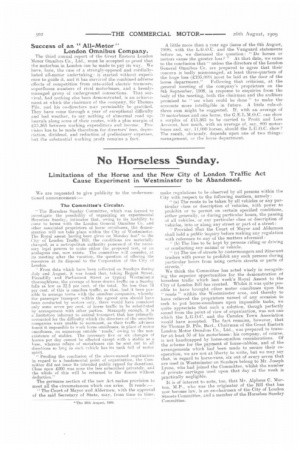Success of an " All-Motor " London Omnibus Company.
Page 2

If you've noticed an error in this article please click here to report it so we can fix it.
The third annual report of the Great Eastern London Motor Omnibus Co., Ltd., must be accepted as proof that the motorbus in London can be made to pay its way. We have, here, the case of a strongly-opposed and cordiallyhated all-motor undertaking: it started without experience to guide it, and it has survived the combined adverse effects of competition from rate-aided electric tramcars, superfluous numbers of rival motorbuses, and a keenlymanaged group of underground connections. That survival, had nothing else been demonstrated, is an achievement at which the chairman of the company, Sir Thomas Pile, and his co-directors may permissibly be gratified. They have come through a year of exceptional difficulty and bad weather, to say nothing of abnormal road upheavals along some of their routes, with a plus margin of i:15.365 between working expenditure and income. Provision has to be made therefrom for directors' fees, depreeiation, dividend, and reduction of preliminary expenses, but the substantial working profit remains a fact.
A little more than a year ago (issue of the 6th August, 1908). with the L.G.O.C. and the Vanguard statements before us, we discussed the question: " Do horses or motors cause the greater loss? " At that date, we came to the conclusion that" unless the directors of the London, General Omnibus Co. are prepared to agree that their concern is badly mismanaged, at least three-quarters of the huge loss (R,195.000) must be laid at the door of the horse department." Following that criticism, at the general meeting of the company's proprietors on the 8th September, 1908, in response to enquiries from the body of the meeting, both the chairman and the auditors promised to " see what could be done" to make the accounts more intelligible in future. A little rule-ofthree sum might be suggested. If, with an average of 70 motorbuses and one horse, the G.E.L.M.O.C. can show a surplus of £1.5,365 to be carried to Profit and Loss Account., how much, with an average of, say, 800 motorbuses and, say, 11,000 horses, should the L.C.O.C. show ? The result, obviously, depends upon one of two things: management, or the horse department.






















